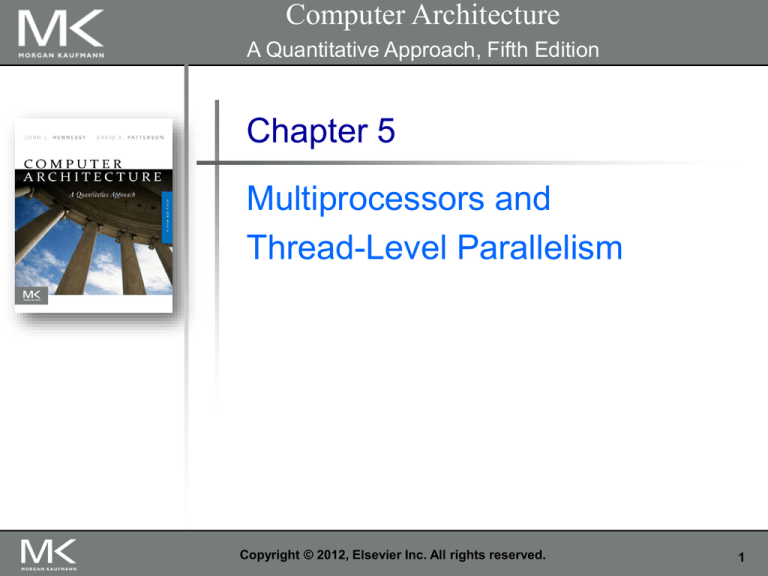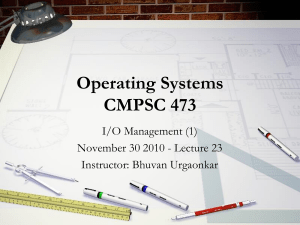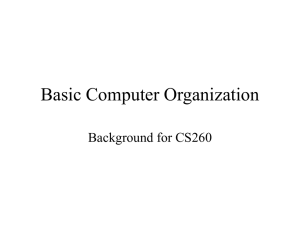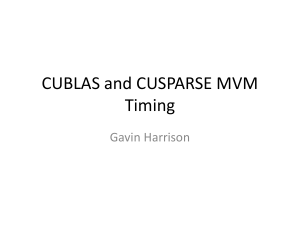
Computer Architecture
A Quantitative Approach, Fifth Edition
Chapter 5
Multiprocessors and
Thread-Level Parallelism
Copyright © 2012, Elsevier Inc. All rights reserved.
1
Thread-Level parallelism
Have multiple program counters
Uses MIMD model
Targeted for tightly-coupled, shared-memory
multiprocessors
For n processors, need n threads
Amount of computation assigned to each thread
= grain size
Introduction
Introduction
Threads can be used for data-level parallelism, but
the overhead may outweigh the benefit.
Copyright © 2012, Elsevier Inc. All rights reserved.
2
Symmetric multiprocessors
(SMP)
Introduction
Types
Small number of cores
Share single memory with
uniform memory latency
Distributed shared memory
(DSM)
Memory distributed among
processors
Non-uniform memory
access/latency (NUMA)
Processors connected via
direct (switched) and nondirect (multi-hop)
interconnection networks
Copyright © 2012, Elsevier Inc. All rights reserved.
3
Centralized Memory
Multiprocessor
•
•
•
•
Also called symmetric multiprocessors (SMPs)
because single main memory has a symmetric
relationship to all processors
Large caches single memory can satisfy
memory demands of small number of processors
Can scale to a few dozen processors by using a
switch and by using many memory banks
Although scaling beyond that is technically
conceivable, it becomes less attractive as the
number of processors sharing centralized memory
increases
CSE 820
4
4
Distributed Memory Multiprocessor
•
Pro: Cost-effective way to scale memory
bandwidth
•
•
•
•
If most accesses are to local memory
Pro: Reduces latency of local memory accesses
Con: Communicating data between processors
more complex
Con: Must change software to take advantage of
increased memory BW
CSE 820
5
5
Communication and Memory
Architecture
1.
2.
Communication occurs by explicitly passing
messages among the processors:
message-passing multiprocessors
Communication occurs through a shared
address space (via loads and stores):
shared memory multiprocessors either
•
•
UMA (Uniform Memory Access time) for shared
address, centralized memory MP
NUMA (Non Uniform Memory Access time
multiprocessor) for shared address, distributed
memory MP
In past, confusion whether “sharing” means
CSE 820
6 MP) or
sharing physical memory
(Symmetric
6
Challenges of Parallel
Processing
1.
2.
Application parallelism primarily via new
algorithms that have better parallel performance
Long remote latency impact both by architect
and by the programmer
For example, reduce frequency of remote
accesses either by
Caching shared data (HW)
Restructuring the data layout to make more accesses
local (SW)
Today’s lecture on HW to help latency via
caches
CSE 820
7
7
Processors may see different values
through their caches:
Copyright © 2012, Elsevier Inc. All rights reserved.
Centralized Shared-Memory Architectures
Cache Coherence
8
Example Cache Coherence
Problem
P2
P1
u= ?
$
P3
4
$
5
$
u :5 u= 7
u :5
1
3
u= ?
2
u:5
I/O devices
Memory
Processors see different values for u after event 3
With write-back caches, value written back to memory depends on
happenstance of which cache flushes or writes back value
Processes accessing main memory may see very stale value
Unacceptable for programming, and its frequent!
CSE 820
9
9
Coherence
Consistency
All reads by any processor
must return the most recently written value.
Writes to the same location by any two processors
are seen in the same order by all processors.
When a written value will be returned by a read
If a processor writes location A followed by location B,
any processor that sees the new value of B
must also see the new value of A.
Centralized Shared-Memory Architectures
Cache Coherence
Coherence: same memory location
Consistency: different memory locations
Copyright © 2012, Elsevier Inc. All rights reserved.
10
A memory system is coherent if
A read by P of X that follows a write by P of X, with no
other write of X by another processor occurring between
the write and the read by P,
always returns the value written by P.
A read by P of X that follows a write to X by another
processor returns the written value,
if the read and write are sufficiently separated in time and
no other writes to X occur between the two accesses.
Writes to the same location are serialized; i.e. two writes
to the same location by any two processors are seen in
the same order by all processors.
Copyright © 2012, Elsevier Inc. All rights reserved.
11
Try it
Come up with examples:
a.
coherent, but not consistent
b.
consistent, but not coherent
c.
neither
d.
both
Copyright © 2012, Elsevier Inc. All rights reserved.
12
Rules
A write does not complete
(and allow the next write to occur) until
all processors have seen the effect of that write.
The processor does not change the order of any
write with respect to any other memory access.
Effectively:
a processor is allowed to reorder reads,
but is forced to finish writes in program order.
Copyright © 2012, Elsevier Inc. All rights reserved.
13
Coherent caches provide:
Migration: movement of data
Replication: multiple copies of data
Cache coherence protocols
Directory based
Sharing status of each block kept in one location
Snooping
Centralized Shared-Memory Architectures
Enforcing Coherence
Each core tracks sharing status of each block
Copyright © 2012, Elsevier Inc. All rights reserved.
14
Basic Schemes for Enforcing Coherence
Program on multiple processors will normally
have copies of the same data in several caches
Rather than trying to avoid sharing in SW,
SMPs use a HW protocol to maintain coherent
caches
Migration and Replication key to performance of shared data
Migration - data can be moved to a local cache
and used there in a transparent fashion
Unlike I/O, where its rare
Reduces both latency to access shared data that is allocated remotely
and bandwidth demand on the shared memory
Replication – for shared data being
820
15 a copy
simultaneously read,CSEsince
caches make
15
Write invalidate
On write, invalidate all other copies
Use bus to serialize
Write cannot complete until bus access is obtained
Centralized Shared-Memory Architectures
Snoopy Coherence Protocols
Write update
On write, update all copies
Copyright © 2012, Elsevier Inc. All rights reserved.
16
Locating an item when a read miss occurs
In write-back cache, the updated value must be sent
to the requesting processor
Cache lines marked
as shared or exclusive/modified
Only writes to shared lines need an invalidate
broadcast
Centralized Shared-Memory Architectures
Snoopy Coherence Protocols
After this, the line is marked as exclusive
Copyright © 2012, Elsevier Inc. All rights reserved.
17
Copyright © 2012, Elsevier Inc. All rights reserved.
Centralized Shared-Memory Architectures
Snoopy Coherence Protocols
18
Copyright © 2012, Elsevier Inc. All rights reserved.
Centralized Shared-Memory Architectures
Snoopy Coherence Protocols
19
Two Classes of Cache Coherence Protocols
1.
2.
Directory based — Sharing status of a block of
physical memory is kept in just one location, the
directory
Snooping — Every cache with a copy of data
also has a copy of sharing status of block, but
no centralized state is kept
•
•
All caches are accessible via some broadcast medium (a bus or
switch)
All cache controllers monitor or snoop on the medium to
determine whether or not they have a copy of a block that is
requested on a bus or switch access
CSE 820
20
20
Snoopy Cache-Coherence
Protocols
State
Address
Data
B u s
s n o o p
$
$
M
e m
I /
O
C a c h e - m
e m
i n
d e vt icr ea sn s a c t o
Cache Controller “snoops” all transactions
on the shared medium (bus or switch)
Pn
P1
relevant transaction if for a block it contains
take action to ensure coherence
invalidate, update, or supply value
depends on state of the block and the protocol
Either get exclusive access before write via
write invalidate or update
all copies21
on write
CSE 820
21
Example: Write-thru Invalidate
P2
P1
u= ?
$
P3
4
$
5
$
u :5 u= 7
u :5
1
3
u= ?
u:5
u=7
2
I/O devices
Memory
Must invalidate before step 3
Write update uses more broadcast medium
BW
820
22
all recent MPUsCSEuse
write invalidate
22
Architectural Building Blocks
Cache block state transition diagram
Broadcast Medium Transactions (e.g., bus)
Fundamental system design abstraction
Logically single set of wires connect several devices
Protocol: arbitration, command/addr, data
Every device observes every transaction
Broadcast medium enforces serialization of
read or write accesses Write serialization
FSM specifying how disposition of block changes
invalid, valid, dirty
1st processor to get medium invalidates others copies
Implies cannot complete write until it obtains bus
All coherence schemes require serializing accesses to same cache
block
Also, need to find up-to-date copy of cache
block
CSE 820
23
23
Locate up-to-date copy of data
Write-through: get up-to-date copy from
memory
Write-back is harder
Most recent copy can be in a cache
Can use same snooping mechanism
1.
2.
Write through simpler if enough memory BW
Snoop every address placed on the bus
If a processor has dirty copy of requested cache
block, it provides it in response to a read request
and aborts the memory access
Complexity from retrieving cache block from a processor
cache, which can take longer than retrieving it from memory
CSE 820
24
Write-back needs lower
memory bandwidth
24
Cache Resources for WB
Snooping
Normal cache tags can be used for snooping
Valid bit per block makes invalidation easy
Read misses easy since rely on snooping
Writes Need to know if any other copies of the
block are cached
No other copies No need to place write on bus for WB
Other copies Need to place invalidate on bus
CSE 820
25
25
Cache Resources for WB
Snooping
To track whether a cache block is shared, add
extra state bit associated with each cache block,
like valid bit and dirty bit
Write to Shared block Need to place invalidate on bus and
mark cache block as private (if an option)
No further invalidations will be sent for that block
This processor called owner of cache block
Owner then changes state from shared to unshared (a.k.a.
exclusive)
CSE 820
26
26
Cache behavior in response to
bus
Every bus transaction
must check the cache-address tags
A way to reduce interference is to duplicate
tags
could potentially interfere with processor cache accesses
One set for cache access, one set for bus accesses
Another way to reduce interference is to use L2
tags
Since L2 less heavily used than L1
Every entry in L1 cache must be present in the L2 cache, called the
inclusion property
If Snoop gets a hit in L2 cache, then it must arbitrate for the L1 cache
to update the state and possibly retrieve the data, which usually
requires a stall of the processor
CSE 820
27
27
Key concept
Invalidate all other processors’ copies
before writing.
Stated another way: gain exclusive ownership
before writing.
CSE 820
28
28
Example Protocol
Snooping coherence protocol is usually
implemented by incorporating a finite-state
controller in each node
Logically, think of a separate controller
associated with each cache block
That is, snooping operations or cache requests for different blocks can
proceed independently
In implementations, a single controller allows
multiple operations to distinct blocks to proceed
in interleaved fashion
that is, one operation may be initiated before another is completed, even
through only one cache access or one bus access is allowed at time
CSE 820
29
29
Write-through Invalidate
Protocol
2 states per block in each
cache
BusWr / -
as in uniprocessor
state of a block is a p-vector of states
PrRd / BusRd
Hardware state bits associated with blocks PrWr / BusWr
I
that are in the cache
other blocks can be seen as being in invalid
(not-present) state in that cache
Writes invalidate all other
cache copies
V
BusRd / PrRd/ PrWr / BusWr
PrRd:
Processor
Read
can have multiple
simultaneous
readers
of
Processor
Write
block, but writePrWr:
invalidates
them
BusRd: Bus Read
BusWr: Bus Write
CSE 820
State Tag Data
BusWr / BusRd / State Tag Data
P1
Pn
$
$
Bus
Mem
I/O devices
30
Is 2-state Protocol Coherent?
Processor only observes state of memory system by issuing
memory operations
Assume bus transactions and memory operations are atomic and a
one-level cache
all phases of one bus transaction complete before next one starts
processor waits for memory operation to complete before issuing next
with one-level cache, assume invalidations applied during bus transaction
All writes go to bus + atomicity
Writes serialized by order in which they appear on bus (bus order)
=> invalidations applied to caches in bus order
How to insert reads in this order?
Important since processors see writes through reads, so determines whether
write serialization is satisfied
But read hits may happen independently and do not appear on bus or enter
directly in bus order
Let’s understand other ordering issues
CSE 820
31
31
Ordering
P0:
R
P1:
R
P2:
R
R
R
R
R
W
R
R
R
R
R
R
R
W
R
R
Writes establish a partial order
Doesn’t constrain ordering of reads, though
shared-medium (bus) will order read misses too
any order among reads between writes is fine,
as long as in program order
CSE 820
32
32
Example Write Back Snoopy
Protocol
Invalidation protocol, write-back cache
Each memory block is in one state:
Clean in all caches and up-to-date in memory (Shared)
OR Dirty in exactly one cache (Exclusive)
OR Not in any caches
Each cache block is in one state (track these):
Snoops every address on bus
If it has a dirty copy of requested block, provides that block in response to
the read request and aborts the memory access
Shared : block can be read
Exclusive : cache has the only copy, its writeable, and dirty
Invalid : block contains no data (in uniprocessor cache too)
Read misses: cause all caches to snoop bus
Writes to clean blocks are treated as misses
CSE 820
33
33
Write-Back State Machine CPU
CPU Read hit
State machine
for CPU requests
for each
cache block
Non-resident
blocks invalid
Invalid
CPU Read
Shared
Place read miss(read/onl
y)
on bus
CPU Write
Place Write
Miss on bus
CPU Write
Place Write Miss on Bus
Cache Block
State
Exclusive
CPU read hit (read/wri
te)
CPU write hit
CSE 820
CPU Write Miss (?)
Write back cache block
Place write miss on bus
34
34
Write-Back State Machine- Bus
request
State machine
for bus requests
for each
cache block
Invalid
Write miss
for this block
Write Back
Block; (abort
memory access)
Exclusive
(read/wri
te)
CSE 820
Write miss
for this block
Shared
(read/onl
y)
Read miss
for this block
Write Back
Block; (abort
memory
access)
35
35
Block-replacement
State machine
for CPU requests
for each
cache block
Invalid
Italics indicate new states
CPU Read hit
CPU Read
Shared
Place read miss(read/onl
y)
on bus
CPU Write
Place Write CPU read miss
Miss on bus Write back block,
Place read miss
on bus
CPU Read miss
Place read miss
on bus
CPU Write
Place Write Miss on Bus
Cache Block
State
Exclusive
CPU read hit (read/wri
te)
CPU write hit
CSE 820
CPU Write Miss
Write back cache block
Place write miss on bus
36
36
Write-back State Machine: showing all
transitions
CPU Read hit
State machine
for CPU requests
for each
cache block and
for bus requests
for each
cache block
Write miss
for this block
Shared
CPU Read
Invalid
Place read miss (read/onl
y)
CPU Write on bus
Place Write
Miss on bus
Write miss
CPU read miss
CPU Read miss
for this block
Write back block,
Place read miss
Write Back
Place read miss
CPU Writeon bus
Block; (abort
on bus
Place Write Miss on Bus
memory
Cache Block
Read miss Write Back
access)
for this blockBlock; (abort
Exclusive
State
memory
(read/wri
CPU read hit
access)
CPU Write Miss
te)
CPU write hit
Write back cache block
Place write miss on bus
CSE 820
37
37
Example
step
P1
P1:Write
Write 10
10 to
to A1
P1:P1:
Read
A1A1
Read
P2:
A1
P2: Read
Read A1
P1
State
Addr
P2
Value State
Bus
Addr Value Action Proc. Addr
Memory
Value Addr Value
P2:
P2: Write
Write 20 to
to A1
A1
P2:
A2
P2: Write
Write 40 to
to A2
Assumes A1 and A2 map to same cache block,
initial cache state is invalid
CSE 820
38
38
Example
step
P1
P1:Write
Write 10
10 to
to A1
P1:P1:
Read
A1A1
Read
P2:
A1
P2: Read
Read A1
P1
State
Excl.
Addr
A1
P2
Value State
10
Bus
Addr Value Action Proc. Addr
WrMs
P1
A1
Memory
Value Addr Value
P2:
P2: Write
Write 20 to
to A1
A1
P2:
A2
P2: Write
Write 40 to
to A2
Assumes A1 and A2 map to same cache block
CSE 820
39
39
Example
step
P1
P1:Write
Write 10
10 to
to A1
P1:P1:
Read
A1A1
Read
P2:
A1
P2: Read
Read A1
P1
State
Excl.
Excl.
Addr
A1
A1
P2
Value State
10
10
Bus
Addr Value Action Proc. Addr
WrMs
P1
A1
Memory
Value Addr Value
P2:
P2: Write
Write 20 to
to A1
A1
P2:
A2
P2: Write
Write 40 to
to A2
Assumes A1 and A2 map to same cache block
CSE 820
40
40
Example
step
P1
P1:Write
Write 10
10 to
to A1
P1:P1:
Read
A1A1
Read
P2:
A1
P2: Read
Read A1
P1
State
Excl.
Excl.
Addr
A1
A1
Shar.
A1
P2
Bus
Value State Addr Value Action Proc. Addr
10
WrMs
P1
A1
10
Shar.
A1
RdMs
P2
A1
10
WrBk
P1
A1
Shar.
A1
10
RdDa
P2
A1
Memory
Value Addr Value
10
10
A1
A1
10
10
P2:
P2: Write
Write 20 to
to A1
A1
P2:
A2
P2: Write
Write 40 to
to A2
Assumes A1 and A2 map to same cache block
CSE 820
41
41
Example
step
P1
P1:Write
Write 10
10 to
to A1
P1:P1:
Read
A1A1
Read
P2:
A1
P2: Read
Read A1
P2:
P2: Write
Write 20 to
to A1
A1
P2:
A2
P2: Write
Write 40 to
to A2
P1
State
Excl.
Excl.
Addr
A1
A1
Shar.
A1
Inv.
P2
Bus
Value State Addr Value Action Proc. Addr
10
WrMs
P1
A1
10
Shar.
A1
RdMs
P2
A1
10
WrBk
P1
A1
Shar.
A1
10
RdDa
P2
A1
Excl.
A1
20
WrMs
P2
A1
Memory
Value Addr Value
10
10
A1
A1
A1
10
10
10
Assumes A1 and A2 map to same cache block
CSE 820
42
42
Example
step
P1
Write
P1: Write 10
10 to
to A1
P1:P1:
Read
A1A1
Read
P2:
A1
P2: Read
Read A1
P1
State
Excl.
Excl.
Shar.
P2:
P2: Write
Write 20 to
to A1
A1
P2:
A2
P2: Write
Write 40 to
to A2
Inv.
Addr
A1
A1
A1
P2
Value State
Addr
10
10
Shar.
A1
10
Shar.
A1
Excl.
A1
Excl.
A2
Bus
Value Action Proc. Addr
WrMs
P1
A1
10
20
40
RdMs
WrBk
RdDa
WrMs
WrMs
WrBk
P2
P1
P2
P2
P2
P2
A1
A1
A1
A1
A2
A1
Memory
Value Addr Value
10
10
20
A1
A1
A1
A1
A1
10
10
10
10
20
Assumes A1 and A2 map to same cache block,
but A1 != A2
CSE 820
43
43
Complications for the basic MSI protocol:
Operations are not atomic
E.g. detect miss, acquire bus, receive a response
Creates possibility of deadlock and races
One solution: processor that sends invalidate can hold bus
until other processors receive the invalidate
Extensions:
Add exclusive state to indicate clean block in only one
cache (MESI protocol)
Centralized Shared-Memory Architectures
Snoopy Coherence Protocols
Prevents needing to write invalidate on a write
Owned state
Copyright © 2012, Elsevier Inc. All rights reserved.
44
Shared memory bus
and snooping
bandwidth is
bottleneck for scaling
symmetric
multiprocessors
Duplicating tags
Place directory in
outermost cache
Use crossbars or pointto-point networks with
banked memory
Copyright © 2012, Elsevier Inc. All rights reserved.
Centralized Shared-Memory Architectures
Coherence Protocols: Extensions
45
AMD Opteron:
Memory directly connected to each multicore chip in
NUMA-like organization
Implement coherence protocol using point-to-point
links
Use explicit acknowledgements to order operations
Copyright © 2012, Elsevier Inc. All rights reserved.
Centralized Shared-Memory Architectures
Coherence Protocols
46
Coherence influences cache miss rate
Coherence misses
True sharing misses
Write to shared block (transmission of invalidation)
Read an invalidated block
False sharing misses
Read an unmodified word in an invalidated block
Copyright © 2012, Elsevier Inc. All rights reserved.
Performance of Symmetric Shared-Memory Multiprocessors
Performance
47
Copyright © 2012, Elsevier Inc. All rights reserved.
Performance of Symmetric Shared-Memory Multiprocessors
Performance Study: Commercial Workload
48
Copyright © 2012, Elsevier Inc. All rights reserved.
Performance of Symmetric Shared-Memory Multiprocessors
Performance Study: Commercial Workload
49
Copyright © 2012, Elsevier Inc. All rights reserved.
Performance of Symmetric Shared-Memory Multiprocessors
Performance Study: Commercial Workload
50
Copyright © 2012, Elsevier Inc. All rights reserved.
Performance of Symmetric Shared-Memory Multiprocessors
Performance Study: Commercial Workload
51
Directory keeps track of every block
Implement in shared L3 cache
Which caches have each block
Dirty status of each block
Keep bit vector of size = # cores for each block in L3
Not scalable beyond shared L3
Implement in a distributed fashion:
Copyright © 2012, Elsevier Inc. All rights reserved.
Distributed Shared Memory and Directory-Based Coherence
Directory Protocols
52
For each block, maintain state:
Shared
Uncached
Modified
One or more nodes have the block cached, value in memory
is up-to-date
Set of node IDs
Exactly one node has a copy of the cache block, value in
memory is out-of-date
Owner node ID
Directory maintains block states and sends
invalidation messages
Copyright © 2012, Elsevier Inc. All rights reserved.
Distributed Shared Memory and Directory-Based Coherence
Directory Protocols
53
Copyright © 2012, Elsevier Inc. All rights reserved.
Distributed Shared Memory and Directory-Based Coherence
Messages
54
Copyright © 2012, Elsevier Inc. All rights reserved.
Distributed Shared Memory and Directory-Based Coherence
Directory Protocols
55
For uncached block:
Read miss
Write miss
Requesting node is sent the requested data and is made the
only sharing node, block is now shared
The requesting node is sent the requested data and becomes
the sharing node, block is now exclusive
For shared block:
Read miss
The requesting node is sent the requested data from
memory, node is added to sharing set
Write miss
Distributed Shared Memory and Directory-Based Coherence
Directory Protocols
The requesting node is sent the value, all nodes in the
sharing set are sent invalidate messages, sharing set only
contains requesting node, block is now exclusive
Copyright © 2012, Elsevier Inc. All rights reserved.
56
For exclusive block:
Read miss
Data write back
The owner is sent a data fetch message, block becomes
shared, owner sends data to the directory, data written
back to memory, sharers set contains old owner and
requestor
Block becomes uncached, sharer set is empty
Write miss
Message is sent to old owner to invalidate and send the
value to the directory, requestor becomes new owner,
block remains exclusive
Copyright © 2012, Elsevier Inc. All rights reserved.
Distributed Shared Memory and Directory-Based Coherence
Directory Protocols
57
Basic building blocks:
Atomic exchange
Swaps register with memory location
Test-and-set
Synchronization
Synchronization
Sets under condition
Fetch-and-increment
Reads original value from memory and increments it in memory
Requires memory read and write in uninterruptable instruction
load linked/store conditional
If the contents of the memory location specified by the load linked
are changed before the store conditional to the same address, the
store conditional fails
Copyright © 2012, Elsevier Inc. All rights reserved.
58
Synchronization
Implementing Locks
Spin lock
lockit:
lockit:
If no coherence:
DADDUI
EXCH
BNEZ
R2,R0,#1
R2,0(R1)
R2,lockit
;atomic exchange
;already locked?
R2,0(R1)
R2,lockit
R2,R0,#1
R2,0(R1)
R2,lockit
;load of lock
;not available-spin
;load locked value
;swap
;branch if lock wasn’t 0
If coherence:
LD
BNEZ
DADDUI
EXCH
BNEZ
Copyright © 2012, Elsevier Inc. All rights reserved.
59
Advantage of this scheme: reduces memory
traffic
Copyright © 2012, Elsevier Inc. All rights reserved.
Synchronization
Implementing Locks
60
Processor 1:
A=0
…
A=1
if (B==0) …
Should be impossible for both if-statements to be
evaluated as true
Processor 2:
B=0
…
B=1
if (A==0) …
Delayed write invalidate?
Sequential consistency:
Result of execution should be the same as long as:
Models of Memory Consistency: An Introduction
Models of Memory Consistency
Accesses on each processor were kept in order
Accesses on different processors were arbitrarily interleaved
Copyright © 2012, Elsevier Inc. All rights reserved.
61
To implement, delay completion of all memory
accesses until all invalidations caused by the
access are completed
Reduces performance!
Alternatives:
Program-enforced synchronization to force write on
processor to occur before read on the other processor
Requires synchronization object for A and another for B
“Unlock” after write
“Lock” after read
Copyright © 2012, Elsevier Inc. All rights reserved.
Models of Memory Consistency: An Introduction
Implementing Locks
62
Rules:
X→Y
Operation X must complete before operation Y is done
Sequential consistency requires:
Relax W → R
“Total store ordering”
Relax W → W
R → W, R → R, W → R, W → W
“Partial store order”
Models of Memory Consistency: An Introduction
Relaxed Consistency Models
Relax R → W and R → R
“Weak ordering” and “release consistency”
Copyright © 2012, Elsevier Inc. All rights reserved.
63
Consistency model is multiprocessor specific
Programmers will often implement explicit
synchronization
Speculation gives much of the performance
advantage of relaxed models with sequential
consistency
Basic idea: if an invalidation arrives for a result that
has not been committed, use speculation recovery
Copyright © 2012, Elsevier Inc. All rights reserved.
Models of Memory Consistency: An Introduction
Relaxed Consistency Models
64










